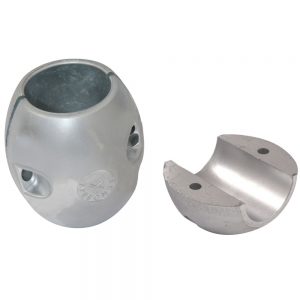Use of Sacrificial Anodes on CB-Series Data Buoys
Sacrificial zinc anodes are recommended for use on CB-Series data buoys any time they will be used in saltwater environments. This helps to prevent corrosion on the stainless steel frame, as zinc is a more active metal that will be consumed while protecting the stainless steel.
NexSens Sacrificial Anodes
Anodes sourced from NexSens are sized specifically for installation onto buoy frames and instrument cages using a pair of screws provided with the anode. They will typically need to be replaced approximately every 6 months, though this may vary depending on factors such as the temperature and salinity of the saltwater environment. Buoys should be regularly inspected and anodes replaced any time it appears they will be consumed before the next scheduled maintenance. It is often a good idea to have two anodes installed onto a buoy – one on the frame and one on the cage – and replace them intermittently to ensure that there is always sufficient protection for the stainless steel. Anode replacement will require a 4-mm Allen wrench to remove the pair of screws connecting the two anode halves.
Zinc as Anode Material
Zinc is chosen for the anode material because it is a readily-available metal with a lower reduction potential (-0.76V) than the steel of the buoy frame. This offers the steel what is known as cathodic protection, where oxidation reactions are transferred away from the steel to the zinc when placed in highly ionic environments such as saltwater in the case of a buoy. The zinc is slowly consumed by the process, hence the term sacrificial anode.
In theory, other materials besides zinc can be used as the anode as long as they rank lower on the reduction potential scale than the stainless steel. Generally speaking, the larger the difference between the metals on the scale, the faster the rate of the oxidation-reduction reaction. Materials with lower reduction potential than zinc may therefore be consumed more rapidly and require more frequent changes. Regardless of anode material chosen, frequent inspection and replacement of anodes as needed can extend the life of a data buoy significantly in saltwater.
Sacrificial anodes are normally not necessary for buoys used in freshwater except in special circumstances. It is therefore generally recommended only to order anodes with buoys intended for use in brackish or saltwater.

